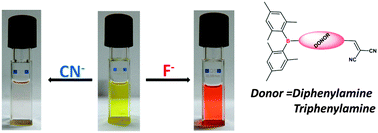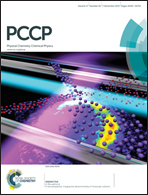Triarylborane conjugated dicyanovinyl chromophores: intriguing optical properties and colorimetric anion discrimination†
Abstract
Three new triarylborane conjugated dicyanovinyl chromophores (Mes2B–π–donor–DCV); donor: N-methyldiphenylamine (1) and triphenylamine (2 and 3 [with two BMes2 substitutions]) of type A–D–A (acceptor–donor–acceptor) are reported. Compounds 1–3 exhibit intense charge transfer (CT) absorption bands in the visible region. These absorption peaks are combination CT bands of the amine donor to both the BMes2 and DCV units. This inference was supported by theoretical studies. Compound 1 shows weak fluorescence compared to 2 and 3. The discrimination of fluoride and cyanide ions is essential in the case of triarylborane (TAB) based anion sensors as a similar response is given towards both the anions. Anion binding studies of 1, 2 and 3 showed that fluoride ions bind selectively to the boron centre and block the corresponding CT transition (donor to BMes2) leaving the other CT transition to be red shifted. On the other hand, cyanide ions bind with both the receptor sites and stop both the CT transition processes and hence a different colorimetric response was noted. The binding of F−/CN− induces colour changes in the visible region of the electronic spectra of 2 and 3, which allows for the naked-eye detection of F− and CN− ions. The anion binding mechanisms are established using NMR titration experiments.


 Please wait while we load your content...
Please wait while we load your content...